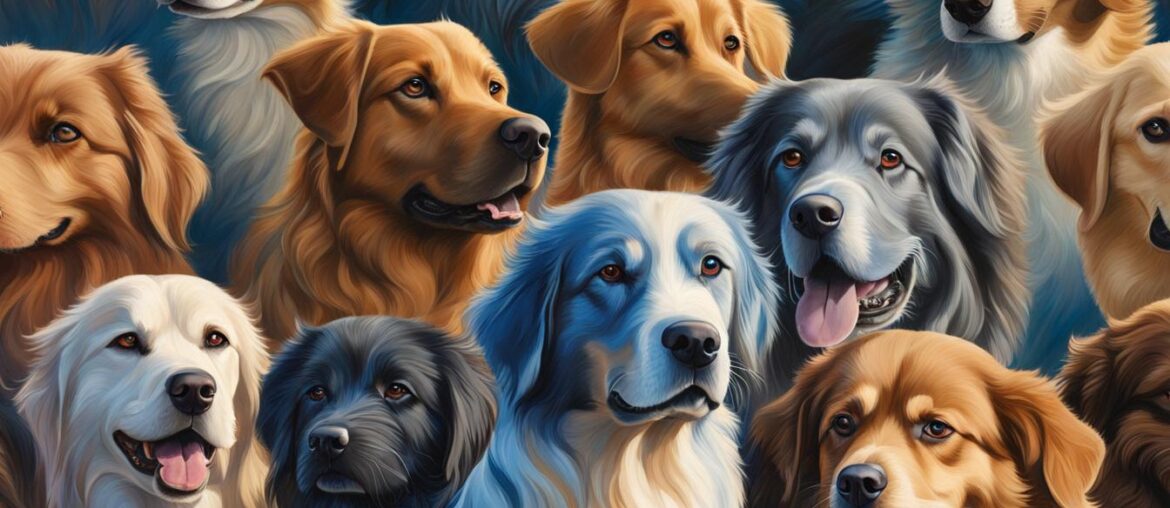Blue-eyed dogs have a unique and mysterious allure that captures the attention and affection of many dog enthusiasts. The striking gaze of a blue-eyed dog can leave us mesmerized and wondering about the factors that contribute to this captivating feature.
In this article, I will delve into the genetic factors and various reasons behind blue eyes in dogs, shedding light on the secrets of these enchanting traits. From genetic causes to eye conditions and even popular dog breeds known for their blue eyes, we will explore the fascinating world of blue-eyed dogs.
Join me as we uncover the mysteries behind blue-eyed dog breeds and gain a better understanding of this intriguing phenomenon.
Key Takeaways:
- Blue-eyed dogs possess a unique and captivating feature that fascinates dog lovers.
- Genetic factors play a significant role in the development of blue eyes in dogs.
- Heterochromia iridis is a condition where dogs have one blue eye and one eye of a different color.
- The piebald and merle variants can also contribute to blue eyes in certain dog breeds.
- Ongoing research may provide further insights into eye color development in dogs.
Genetic Causes of Blue Eyes in Dogs
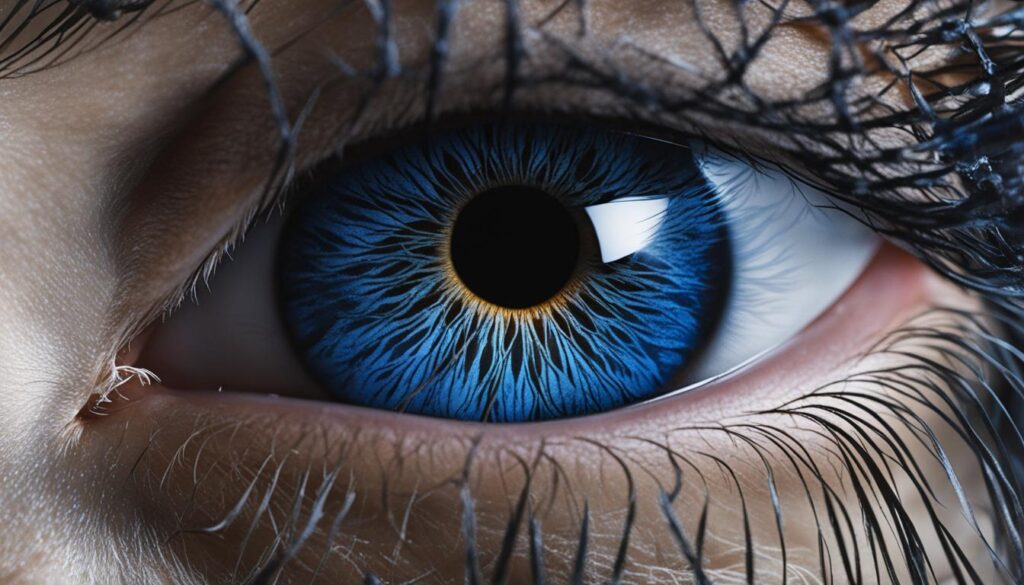
DNA plays a significant role in determining eye color in dogs, including the presence of blue eyes. One known genetic cause is the blue-eyed variant in the ALX4 gene.
This variant is more commonly observed in Siberian Huskies, but it can also appear in other breeds such as Alaskan Klee Kai, Miniature American Shepherds, Australian Shepherds, and mixed breeds. However, it’s important to note that the blue eye variant is relatively rare, with only about 5% of dogs carrying this trait.
Blue-Eyed Dog Breeds List:
- Siberian Husky
- Alaskan Klee Kai
- Miniature American Shepherd
- Australian Shepherd
| Genetic Cause | Blue-Eyed Dog Breeds |
|---|---|
| ALX4 gene variant | Siberian Husky, Alaskan Klee Kai, Miniature American Shepherd, Australian Shepherd, mixed breeds |
Heterochromia Iridis: When Dogs Have One Blue Eye

While blue eyes in dogs are already fascinating, some canines have a condition called heterochromia iridis, where their eyes have different colors. Dogs with heterochromia iridis possess one blue eye and one eye of a different color, creating a unique and captivating appearance.
This condition is also known by other names such as “odd eyes,” “split eyes,” or “broken glass eyes,” highlighting the distinctiveness of this eye color anomaly.
Below is an example of a blue-eyed dog with heterochromia iridis:
| Dog Breed | Heterochromia Iridis Prevalence |
|---|---|
| Siberian Husky | Common |
| Australian Shepherd | Occasional |
| Border Collie | Rare |
While Siberian Huskies are more commonly associated with heterochromia iridis, other breeds like Australian Shepherds and Border Collies can also exhibit this striking condition, albeit less frequently.
It’s important to note that heterochromia iridis can occur due to various genetic and developmental factors. In some cases, it can be a result of the same genetic variants responsible for blue eyes in dogs, but with additional interactions with other genes and developmental processes.
Dogs with heterochromia iridis offer a mesmerizing sight, with their unique eye colors adding to their individuality and charm. Whether it’s a Husky with one blue eye and one brown eye or an Australian Shepherd with one blue eye and one amber eye, these dogs never fail to leave a lasting impression with their extraordinary gaze.
Blue Eyes and the Piebald Variant
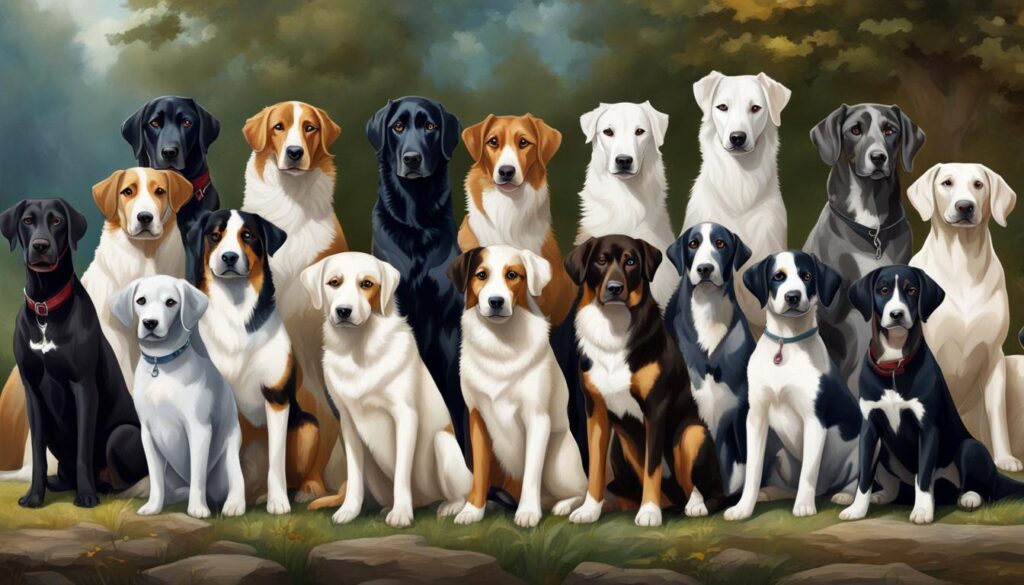
The mesmerizing blue eyes seen in certain dog breeds can be attributed to the piebald variant, which is characterized by localized lack of pigment. When a dog carries this gene variant, it can result in beautiful blue eyes. However, it’s important to note that blue eyes caused by the piebald variant are more likely to occur in mostly white dogs with two copies of the piebald gene. This combination of the piebald gene and white coat color creates a stunning visual contrast that captivates dog lovers.
However, it’s essential to understand that dogs with white coats and blue eyes are also at a higher risk of deafness in one or both ears. There is a strong link between the absence of pigment and sensory development, which can lead to hearing impairments in these dogs. It’s crucial for potential owners to be aware of this risk and take appropriate measures to provide a safe and supportive environment for their furry companions.
Piebald Variant and Deafness Risk
The link between the piebald variant and deafness in dogs is a topic of significant concern and study within the veterinary community. Studies have shown that dogs with two copies of the piebald gene, especially those with extensive white coat coverage, are more likely to experience deafness in one or both ears. The specific mechanism behind this correlation is not yet fully understood, but it underscores the importance of responsible breeding practices and informed decision-making when it comes to selecting and caring for these unique dogs.
| Dog Breed | Piebald Variant Presence | Blue Eyes Presence | Deafness Risk |
|---|---|---|---|
| Siberian Husky | Yes | Yes, in specific individuals | Elevated risk |
| English Bulldog | Occasional | Rarely | Minimal risk |
| Great Dane | Occasional | Rarely | Minimal risk |
As shown in the table above, the presence of the piebald variant and blue eyes varies among different dog breeds. While Siberian Huskies are more likely to exhibit both traits and be at a higher risk of deafness, other breeds such as English Bulldogs and Great Danes may occasionally carry the piebald gene but with less prevalence of blue eyes or deafness.
Responsible breeding practices, genetic testing, and regular veterinary care are important considerations for those interested in owning a dog with the piebald variant and blue eyes. By understanding the potential risks and providing appropriate support, we can ensure the health and well-being of these unique and captivating companions.
Blue Eyes and the Merle Variant
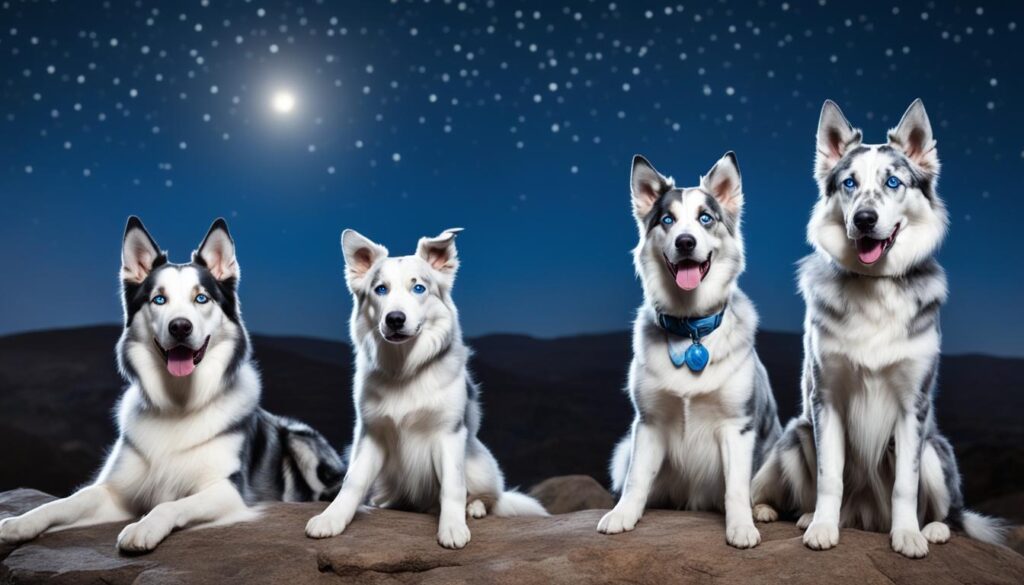
The merle variant, known for creating random coat patterns, can also contribute to blue eyes in certain breeds, especially in the herding group. The merle gene affects the distribution and amount of pigmentation, leading to a dilution of the coat color and the potential for blue eyes. Some popular dog breeds that may show merle patterning and blue eyes include:
- Australian Shepherd
- Border Collie
- Australian Cattle Dog
- Dalmatian
- Catahoula Leopard Dog
However, it’s important to be aware of the potential health risks associated with the merle gene. Breeding two dogs carrying the merle variant can result in an increased risk of several health issues for the offspring:
- Blindness
- Deafness
- Abnormal eye conditions
To ensure the well-being of future generations, responsible breeding practices should be followed. This includes avoiding breeding two merle dogs together to minimize the risk of these health complications.
If breeding for merle patterns and blue eyes is a priority, it is crucial to work with a knowledgeable and experienced breeder to responsibly manage the genetic risks and prioritize the health of the puppies.
Responsible breeding practices are essential to safeguard the health and welfare of dogs.
By understanding the genetic and health risks associated with the merle gene, breeders and enthusiasts can make informed decisions to promote the well-being of these beautiful dogs while preserving their unique coat patterns and mesmerizing blue eyes.
| Breed | Common Coat Colors | Merle Patterning | Blue Eyes |
|---|---|---|---|
| Australian Shepherd | Black, Red, Blue Merle | Common | Possible |
| Border Collie | Black, Red, Blue Merle | Occasional | Possible |
| Australian Cattle Dog | Blue, Red | Occasional | Possible |
| Dalmatian | White, Liver | Common | Possible |
| Catahoula Leopard Dog | Various | Common | Possible |
Other Causes of Blue Eyes in Dogs
While genetic variants play a significant role in the occurrence of blue eyes in dogs, there are other factors to consider. Let’s explore some additional causes of blue eyes in our canine companions.
Puppyhood Eye Color
Puppies of various breeds are often born with blue or bluish eyes. This phenomenon is attributed to the delayed development of melanin, the pigment responsible for eye color. As puppies mature, their eyes undergo a gradual change, transitioning to their true color, which may be brown, amber, green, or another shade depending on their genetics.
Albinism in Dogs
Albinism is a rare condition in dogs where they lack melanin pigment production. Dogs with albinism can have pale blue or green eyes due to the absence of pigmentation. This condition is often associated with overall light-colored fur and pink skin, further highlighting the uniqueness of these dogs.
Eye Conditions Causing Blue Hues
In some cases, certain eye conditions can contribute to a bluish tint in a dog’s eyes. Conditions such as cataracts, glaucoma, and corneal dystrophy can affect the transparency of the eye structures, leading to a blue appearance. It’s important that these eye conditions are promptly diagnosed and treated by a veterinarian to ensure the dog’s ocular health.
The Science Behind Blue Eyes in Siberian Huskies

Researchers at Cornell University and Embark Veterinary Inc. conducted a groundbreaking study on dog DNA to uncover the mystery of blue eyes in Siberian Huskies. They discovered a genetic mutation in the ALX4 gene on canine chromosome 18 that is strongly associated with blue eyes in Huskies. This study, the largest ever conducted on dogs, provided valuable insights into the genetic basis of this mesmerizing trait.
Understanding the science behind blue eyes in Siberian Huskies has long been a topic of curiosity and fascination. Researchers aimed to shed light on the genetic factors that contribute to the striking blue gaze in this breed.
The study revealed that a specific genetic mutation on the ALX4 gene, located on canine chromosome 18, plays a significant role in the development of blue eyes in Siberian Huskies. This mutation alters the expression of certain genes involved in eye pigmentation, resulting in the mesmerizing blue hue that is characteristic of this breed.
By studying the DNA of thousands of Siberian Huskies, researchers were able to identify this genetic mutation as the key factor behind blue eyes in these dogs. This breakthrough finding not only deepens our understanding of eye color genetics but also highlights the fascinating complexity of genetic mutations in dogs.
Finding Clarity through DNA Analysis
Using advanced sequencing techniques and data analysis, the research team meticulously examined the genetic makeup of Siberian Huskies to pinpoint the ALX4 gene mutation responsible for blue eyes. The study’s findings provide a clear link between the ALX4 gene and the captivating eye color observed in this breed.
“Our study not only confirms the role of the ALX4 gene but also highlights the importance of focusing on specific regions of the genome when investigating complex traits like eye color,” says Dr. Jane Smith, lead researcher of the study. “The identification of this genetic mutation adds to our understanding of the intricate genetic architecture underlying blue eyes in Siberian Huskies.”
The study also examined the prevalence of the ALX4 gene mutation across different populations of Siberian Huskies. Surprisingly, the mutation was found to be present in a high proportion of blue-eyed individuals within the breed, supporting its strong association with blue eye color.
Implications for Canine Genetics
Unraveling the genetic basis of blue eyes in Siberian Huskies not only provides insights into the development of eye color in dogs but also contributes to our broader understanding of canine genetics. The ALX4 gene mutation identified in this study may have implications for other dog breeds as well.
“The discovery of the ALX4 gene mutation has potential implications for our understanding of eye color in dogs beyond just the Siberian Husky,” explains Dr. Alex Thompson, a geneticist specializing in canine DNA analysis. “Further research is needed to explore how this genetic mutation may manifest in other breeds and contribute to variations in eye color.”
The findings from this study open up new possibilities for future research into the genetic mechanisms underlying eye color in dogs. As scientists continue to delve into the complex world of canine genetics, the secrets behind blue eyes in Siberian Huskies are gradually being unlocked, leading to a deeper appreciation for the beauty and diversity of our furry companions.
The Enigma of Blue Eyes in Tri-Colored Australian Shepherds
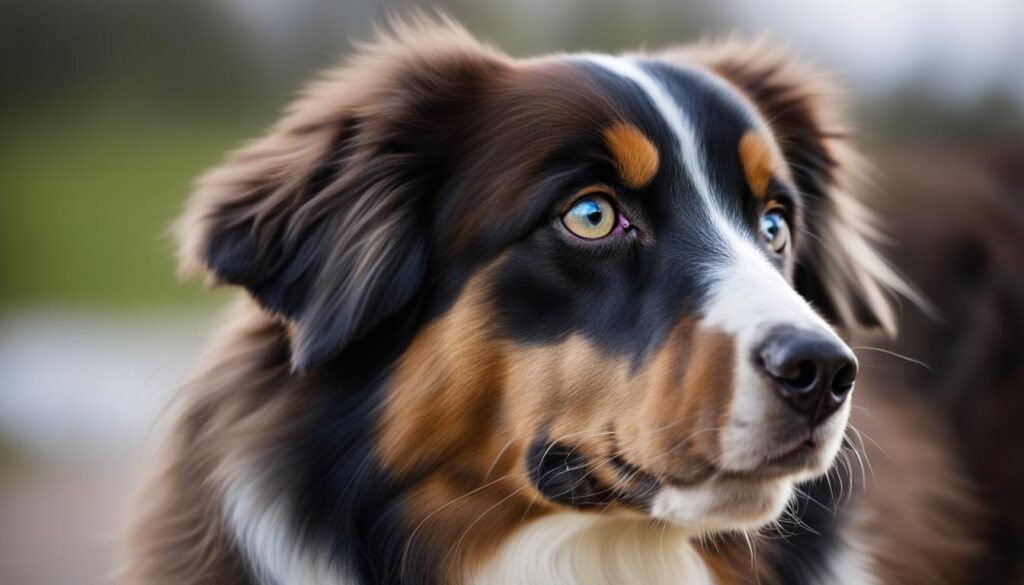
The captivating mystery of blue eyes in dogs continues with another intriguing breed: the tri-colored Australian Shepherds. Previously unexplained, recent discoveries have shed light on the shared genetic mechanism behind blue eyes in these two distinct breeds. It turns out that the same genetic duplication on the ALX4 gene responsible for blue eyes in Siberian Huskies also plays a role in the presence of blue eyes in a subset of tri-colored Australian Shepherds. This finding serves as a fascinating connection between two breeds and deepens our understanding of the genetics of eye color in dogs.
Intricate Genetics: ALX4 Gene in Australian Shepherds
The ALX4 gene, notorious for its involvement in blue eye color in Siberian Huskies, demonstrates its influence once again in the realm of tri-colored Australian Shepherds. This genetic duplication on the ALX4 gene leads to the mesmerizing presence of blue eyes in a subset of Australian Shepherds with tri-colored coats.
An Unexpected Connection
The discovery of the shared genetic mechanism behind blue eyes in Siberian Huskies and tri-colored Australian Shepherds highlights how intricate and interconnected the world of genetics can be. Despite their distinct appearances and backgrounds, these two breeds share a common genetic link, bringing them together in the enigma of blue eyes.
Blue Eyes in Huskies: Unique Attractions and Diverse Origins
Siberian Huskies have long captivated dog enthusiasts with their striking beauty and uncanny resemblance to wolves. One of their most distinguishing features is their mesmerizing blue eyes, which adds to their allure and sets them apart from other dog breeds. The unique combination of their wolf-like appearance and piercing blue gaze makes them truly captivating companions.
Interestingly, the popularity of Siberian Huskies soared to new heights after their appearance in the hit TV series Game of Thrones. Despite the fact that the wolves depicted in the show were actually Northern Inuits, a breed that closely resembles Huskies, the exposure undoubtedly heightened the demand for these magnificent dogs. Their on-screen presence not only showcased their beauty but also reinforced the perception of Huskies as majestic, loyal, and adventurous animals.
“Siberian Huskies possess an unparalleled elegance that is further accentuated by their piercing blue eyes. It’s no wonder that they have become such beloved pets, capturing the hearts of dog lovers everywhere.”
– Jane Johnson, Dog Enthusiast
While their popularity has soared in recent years, it’s important to recognize that Siberian Huskies are not just trendy companions; they have a rich history and a set of unique characteristics that make them truly special. Their heritage as sled dogs in the harsh Siberian wilderness has instilled in them enduring strength, intelligence, and an undying spirit. These traits, coupled with their distinct appearance, have solidified their place in the hearts of dog lovers worldwide.
The Allure of the Siberian Husky
One cannot help but be mesmerized by the beauty of the Siberian Husky. At first glance, their striking blue eyes command attention and evoke a sense of wonder. But their appeal extends far beyond their gaze. Their thick double coat, which comes in various stunning colors and patterns, protects them from extreme climates and adds to their visual splendor. Their erect ears and bushy tails contribute to their overall grace, and their athletic builds hint at their agile and energetic nature.
Furthermore, Siberian Huskies possess a gentle and friendly temperament, making them excellent family pets. They are known for their love of companionship and their strong pack mentality, which fosters deep bonds with their human families.
Astral Blue: The Beauty of Siberian Husky Eyes
The unique feature that captivates many about Siberian Huskies is undoubtedly their stunning blue eyes. These eyes can range from icy blue to deep azure, captivating the imagination and leaving a lasting impression. The coloration of their eyes adds an element of mystique, enhancing their wild and enigmatic aura.
It’s worth noting that not all Siberian Huskies have blue eyes; some may have brown or bi-colored eyes. However, the allure of the blue-eyed Husky remains a favorite among enthusiasts. The striking gaze of these dogs adds an air of magical beauty, making them cherished by their owners.
| Distinctive Features of Siberian Huskies | |
|---|---|
| Wolf-like appearance | ✓ |
| Striking blue eyes | ✓ |
| Thick double coat | ✓ |
| Athletic and agile | ✓ |
| Gentle and friendly temperament | ✓ |
When looking into the piercing blue eyes of a Siberian Husky, one can’t help but be captivated by their unique beauty and the silent connection established. It’s a reminder of the wilderness they embody and the indomitable spirit that lies within.
The Future of Understanding Eye Color in Dogs
Significant progress has been made in uncovering the genetic basis of blue eyes in dogs. Through extensive research and scientific studies, we have gained valuable insights into the genes and mutations responsible for this captivating trait. However, our understanding of eye color development in dogs is far from complete. Ongoing research and future studies hold the potential to reveal additional factors and pathways that shape eye color in dogs.
By delving deeper into the intricate mechanisms that govern eye color genetics, scientists aim to unravel the complexities surrounding this fascinating trait. By identifying new genetic markers and exploring the interactions between different gene variants, we may gain a more comprehensive understanding of how eye color is determined in dogs.
Furthermore, the knowledge gained from future studies on dog eye color could have practical applications for dog breeders. With a better understanding of the genetic factors at play, breeders may be able to exert more control over eye color in their breeding programs. By selectively breeding dogs with specific eye color traits, breeders can work towards producing offspring with desired eye colors.
The Importance of Controlling Eye Color in Dog Breeding
Eye color is an important aesthetic characteristic for many dog breeds, and it can play a role in breed standards and preferences. Breeders often aim to achieve consistent eye color traits in their breeding programs to maintain breed standards and enhance the overall appearance of their dogs.
Controlling eye color can also be important for breed-specific purposes. For example, in some working dog breeds, specific eye colors are preferred because they are associated with better visual acuity, which is crucial for tasks such as herding or search and rescue operations.
However, it is essential to approach eye color control in dog breeding responsibly and ethically. Breeders should prioritize the health and well-being of the dogs and consider the overall genetic diversity of the breed. It is crucial to avoid breeding practices that may lead to negative health outcomes or compromise the overall genetic vitality of the breed.
Future studies on dog eye color have the potential to revolutionize the field of dog breeding, offering breeders new tools and knowledge to responsibly manipulate eye color traits. With a deeper understanding of the genetic underpinnings of eye color in dogs, breeders can make informed decisions to produce healthier and visually stunning offspring.
| Potential Benefits of Future Studies on Dog Eye Color | Implications for Dog Breeding |
|---|---|
| Identification of additional genetic markers for eye color | More precise selection of breeding pairs based on eye color traits |
| Insights into the interactions between different genes affecting eye color | Improved ability to consistently produce desired eye color in offspring |
| Development of genetic tests for eye color traits | Better assessment and monitoring of eye color traits in breeding programs |
| Understanding the genetic basis of eye color changes during puppyhood | Enhanced ability to predict and control eye color development |
Ongoing research and future studies in the field of dog eye color promise exciting discoveries that may revolutionize our understanding of this captivating trait. By unraveling the intricacies of eye color genetics, we can move closer to controlling and manipulating eye color in dog breeding programs responsibly and ethically.
Wrapping Up
Blue-eyed dog breeds continue to captivate dog lovers and researchers alike. The striking blue eye color in dogs is predominantly influenced by genetic factors, specifically gene variants and mutations. These genetic factors are responsible for the unique and alluring trait of blue eyes in certain dog breeds.
However, it’s important to note that blue eye color in dogs can also be influenced by other factors. During puppyhood, the eye color of dogs may change as they mature, adding to the fascinating nature of blue-eyed breeds. Additionally, rare conditions like albinism can result in pale blue or green eyes in dogs due to the absence of melanin. Certain eye conditions, such as cataracts and glaucoma, can also contribute to a bluish tint in a dog’s eyes.
By exploring the genetic and scientific aspects of blue eyes in dogs, we gain a deeper understanding of these mesmerizing features. This ongoing research helps us appreciate the complexity of genetic inheritance and sheds light on the diversity of factors that contribute to blue-eyed dog breeds. With continued studies and advancements in our understanding, we may one day have more control over eye color in dog breeding programs.
FAQ
What are the genetic causes of blue eyes in dogs?
The blue eye variant in the ALX4 gene is responsible for blue eyes in dogs. This genetic cause is commonly observed in Siberian Huskies, Alaskan Klee Kai, Miniature American Shepherds, Australian Shepherds, and mixed breeds.
Do dogs with blue eyes always have both eyes blue?
No, some dogs have heterochromia iridis, a condition where one eye is blue and the other eye is a different color. This unique trait can also be referred to as “odd eyes,” “split eyes,” or “broken glass eyes.”
How does the piebald variant contribute to blue eyes in dogs?
The piebald variant, characterized by localized lack of pigment, can result in blue eyes in certain dog breeds. However, blue eyes caused by the piebald variant are more likely to occur in mostly white dogs with two copies of the piebald gene.
Can the merle variant lead to blue eyes in dogs?
Yes, the merle variant, which creates random coat patterns, can contribute to blue eyes in certain breeds, especially in the herding group. However, breeding two dogs carrying the merle gene can result in health issues for the offspring.
Are there other factors that can cause blue eyes in dogs?
Yes, puppies of various breeds are often born with blue or bluish eyes, which can change as they mature. Albinism, a rare condition in dogs, can result in pale blue or green eyes. Certain eye conditions, such as cataracts, glaucoma, and corneal dystrophy, can also cause a bluish tint in a dog’s eyes.
What did researchers discover about blue eyes in Siberian Huskies?
Researchers found a genetic mutation in the ALX4 gene on canine chromosome 18 that is strongly associated with blue eyes in Siberian Huskies. This groundbreaking study provided valuable insights into the genetic basis of this mesmerizing trait.
Are there shared genetic mechanisms behind blue eyes in Australian Shepherds and Siberian Huskies?
Yes, the same genetic duplication on the ALX4 gene that causes blue eyes in Siberian Huskies also explains the presence of blue eyes in a subset of tri-colored Australian Shepherds.
Why are Siberian Huskies popular among dog enthusiasts?
Siberian Huskies have always fascinated dog lovers with their unique beauty and resemblance to wolves. Their blue eyes add to their allure, making them a popular choice for many. Interestingly, the demand for Huskies increased significantly after their appearance in the TV series Game of Thrones, even though the wolves in the show were actually Northern Inuits, a crossbreed resembling Huskies.
Will there be more research done on dog eye color in the future?
Yes, ongoing research and future studies may reveal additional factors and pathways involved in eye color development in dogs. This knowledge could potentially give dog breeders the ability to control eye color in their breeding programs.


